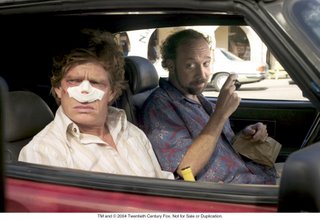Glimpsing Movies

Transcript of a conversation from last night
Alan: What are you watching?
Bryan: Texas Chainsaw Massacre.
Alan: Ah, this seems like an original story.
Bryan: Why don't you judge after having seen three minutes of it?
Transcript of a conversation from last summer (poorly recalled and lexically fabricated)
Alan: Sideways is maybe the worst movie ever made.Diana: You've only seen half of it!
I beleive in the necessity of encountering a work of art in its entirety, that is, in the form intended by its creator. This is why hearing a good song snipped and edited by a radio station appalls me. This is why I read whole novels, and why I do not like "survey" literature courses, especially ones based largely on a bulky Norton Anthology of Literature.
But I recognize that it is often necessary to extrapolate criticism of a part of a work to the work in full. In our media-saturated society, we have endless choices for entertainment and edification. To make the most of our choices, we must engage in extrapolation based on proportionally tiny bits of information.
Our extrapolations are especially suited for commercial moving image forms such as blockbuster movies and television. These forms gave us the trailer and the remote control, which ask us to assess whether we would enjoy a movie or program after seeing one minute or even one second of footage.
Cooler media such as print demand fewer such assessments. But it is still necessary to extrapolate our opinion of books based on very incomplete information. We do this every time we start a book and decide whether to continue it or not. If we don't do this, we will have a less optimized literary experience.
Furthermore, art often takes the form of the fractal: its complete form is contained in its component parts (metaphor credit goes to Josh Gan. The fractal and the energy well are two of the most useful Josh Gan rhetorical metaphors). I beleive that a movie's attitude and style are often contained in each of its scenes. The other weekend, I watched five minutes of The Wedding Singer, and just from observing the scene in which Drew Barrymore practices her wedding kiss on Adam Sandler I could confidently project all of the following onto the movie as a whole.
1) It is a mostly conventional, commercial movie
2) It is light-hearted and populist
3) The presence of Adam Sandler prevents it from degenerating into total romantic cheesiness.
etc.
I was not ready to publish a review of the movie, nor did I feel I fully appreciated its aesthetic or entertainment value. But, incompletely informed though I was, I felt competent enough to determine whether I would want to watch it, to whom I would recommend it, and how I would rate it in terms of conventionality, attitude, and watchability. Thus, I stand by my assessments of movies of which I have only seen a fragment. And truly, anyone who has seen even a tiny bit of Sideways can tell you it is just a godawful film.
